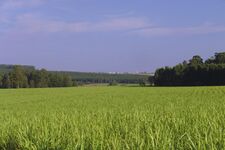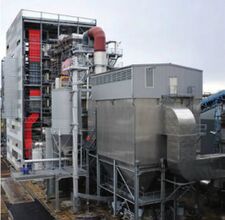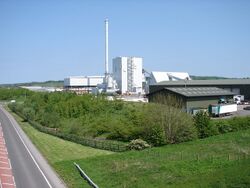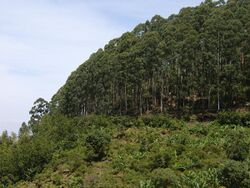Biology:Bioenergy
 | This article may be unbalanced towards certain viewpoints. (May 2023) |
Bioenergy is energy made or generated from biomass, which consists of recently living (but now dead) organisms, mainly plants.[1] Types of biomass commonly used for bioenergy include wood, food crops such as corn, energy crops and waste from forests, yards, or farms.[2] The IPCC (Intergovernmental Panel on Climate Change) defines bioenergy as a renewable form of energy.[3] Bioenergy can either mitigate (i.e. reduce) or increase greenhouse gas emissions. There is also agreement that local environmental impacts can be problematic.
Terminology
Since biomass can be used as a fuel directly (e.g. wood logs), the terms biomass and biofuel have sometimes been used interchangeably. However, the word biomass usually denotes the biological raw material the fuel is made of. The terms biofuel or biogas are generally reserved for liquid or gaseous fuels respectively.[4]
Input materials
Thermal conversion processes use heat as the dominant mechanism to upgrade biomass into a better and more practical fuel. The basic alternatives are torrefaction, pyrolysis, and gasification, these are separated mainly by the extent to which the chemical reactions involved are allowed to proceed (mainly controlled by the availability of oxygen and conversion temperature).[5]
Many chemical conversions are based on established coal-based processes, such as the Fischer-Tropsch synthesis.[6] Like coal, biomass can be converted into multiple commodity chemicals.[7]
Biochemical processes have developed in nature to break down the molecules of which biomass is composed, and many of these can be harnessed. In most cases, microorganisms are used to perform the conversion. The processes are called anaerobic digestion, fermentation, and composting.[8]
Applications
Biomass for heating
Biofuel for transportation
First-generation (or "conventional") biofuels are made from food sources grown on arable lands, such as sugarcane and maize. Sugars present in this biomass are fermented to produce bioethanol, an alcohol fuel which serves as an additive to gasoline, or in a fuel cell to produce electricity. Bioethanol is made by fermentation, mostly from carbohydrates produced in sugar or starch crops such as corn, sugarcane, or sweet sorghum. Bioethanol is widely used in the United States and in Brazil. Biodiesel is produced from the oils in for instance rapeseed or sugar beets and is the most common biofuel in Europe.[citation needed]
Second-generation biofuels (also called "advanced biofuels") utilize non-food-based biomass sources such as perennial energy crops and agricultural residues/waste. The feedstock used to make the fuels either grow on arable land but are byproducts of the main crop, or they are grown on marginal land. Waste from industry, agriculture, forestry and households can also be used for second-generation biofuels, using e.g. anaerobic digestion to produce biogas, gasification to produce syngas or by direct combustion. Cellulosic biomass, derived from non-food sources, such as trees and grasses, is being developed as a feedstock for ethanol production, and biodiesel can be produced from left-over food products like vegetable oils and animal fats.[citation needed]
Production of liquid fuels
Comparison with other renewable energy types
Land requirement
The surface power production densities of a crop will determine how much land is required for production. The average lifecycle surface power densities for biomass, wind, hydro and solar power production are 0.30 W/m2, 1 W/m2, 3 W/m2 and 5 W/m2, respectively (power in the form of heat for biomass, and electricity for wind, hydro and solar).[9] Lifecycle surface power density includes land used by all supporting infrastructure, manufacturing, mining/harvesting and decommissioning.
Another estimate puts the values at 0.08 W/m2 for biomass, 0.14 W/m2 for hydro, 1.84 W/m2 for wind, and 6.63 W/m2 for solar (median values, with none of the renewable sources exceeding 10 W/m2).[10]
Related technologies
Bioenergy with carbon capture and storage (BECCS)
Carbon capture and storage technology can be used to capture emissions from bioenergy power plants. This process is known as bioenergy with carbon capture and storage (BECCS) and can result in net carbon dioxide removal from the atmosphere. However, BECCS can also result in net positive emissions depending on how the biomass material is grown, harvested, and transported. Deployment of BECCS at scales described in some climate change mitigation pathways would require converting large amounts of cropland.[11]
Climate and sustainability aspects
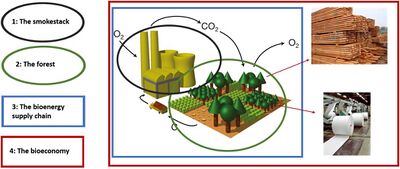
Environmental impacts
Long-distance transport of biomass have been criticised as wasteful and unsustainable,[13] and there have been protests against forest biomass export in Sweden[14] and Canada.[15]
Scale and future trends
Generally, bioenergy expansion fell by 50% in 2020. China and Europe are the only two regions that reported significant expansion in 2020, adding 2 GW and 1.2 GW of bioenergy capacity, respectively.[16]
Almost all available sawmill residue is already being utilized for pellet production, so there is no room for expansion. For the bioenergy sector to significantly expand in the future, more of the harvested pulpwood must go to pellet mills. However, the harvest of pulpwood (tree thinnings) removes the possibility for these trees to grow old and therefore maximize their carbon holding capacity.[17]:19 Compared to pulpwood, sawmill residues have lower net emissions: "Some types of biomass feedstock can be carbon-neutral, at least over a period of a few years, including in particular sawmill residues. These are wastes from other forest operations that imply no additional harvesting, and if otherwise burnt as waste or left to rot would release carbon to the atmosphere in any case."[17]:68
By country
Script error: No such module "World topic".
See also
- Biochar
- Biomass to liquid
- Biorefinery
- European Biomass Association
References
- ↑ "Bioenergy Basics" (in en). https://www.energy.gov/eere/bioenergy/bioenergy-basics.
- ↑ "Biomass – Energy Explained, Your Guide To Understanding Energy". U.S. Energy Information Administration. June 21, 2018. https://www.eia.gov/energyexplained/?page=biomass_home.
- ↑ "Renewable Energy Sources and Climate Change Mitigation. Special Report of the Intergovernmental Panel on Climate Change". https://www.ipcc.ch/site/assets/uploads/2018/03/SRREN_Full_Report-1.pdf.
- ↑ "Biofuels explained - U.S. Energy Information Administration (EIA)". https://www.eia.gov/energyexplained/biofuels/.
- ↑ Akhtar, Krepl & Ivanova 2018.
- ↑ Liu et al. 2011.
- ↑ Conversion technologies . Biomassenergycentre.org.uk. Retrieved on 2012-02-28.
- ↑ "Biochemical Conversion of Biomass" (in en-US). BioEnergy Consult. 2014-05-29. http://www.bioenergyconsult.com/biochemical-conversion-technologies/.
- ↑ Smil, Vaclav (2015). Power density : a key to understanding energy sources and uses. Cambridge, Massachusetts. pp. 26–27, 211, box 7.1. ISBN 978-0-262-32692-6. OCLC 927400712. https://www.worldcat.org/oclc/927400712.
- ↑ Van Zalk, John; Behrens, Paul (2018-12-01). "The spatial extent of renewable and non-renewable power generation: A review and meta-analysis of power densities and their application in the U.S." (in en). Energy Policy 123: 86. doi:10.1016/j.enpol.2018.08.023. ISSN 0301-4215.
- ↑ National Academies of Sciences, Engineering, and Medicine 2019, p. 3.
- ↑ Cowie, Annette L.; Berndes, Göran; Bentsen, Niclas Scott; Brandão, Miguel; Cherubini, Francesco; Egnell, Gustaf; George, Brendan; Gustavsson, Leif et al. (2021). "Applying a science‐based systems perspective to dispel misconceptions about climate effects of forest bioenergy" (in en). GCB Bioenergy 13 (8): 1210–1231. doi:10.1111/gcbb.12844. ISSN 1757-1693. https://onlinelibrary.wiley.com/doi/10.1111/gcbb.12844.
- ↑ IFL Science 2016.
- ↑ Forest Defenders Alliance 2021.
- ↑ STAND.earth 2021.
- ↑ "World Adds Record New Renewable Energy Capacity in 2020" (in en). https://www.irena.org/newsroom/pressreleases/2021/Apr/World-Adds-Record-New-Renewable-Energy-Capacity-in-2020.
- ↑ 17.0 17.1 Brack, D. (2017) Woody Biomass for Power and Heat Impacts on the Global Climate. Research Paper - Environment, Energy and Resources Department.
Sources
- Pishvaee, Mir Saman; Mohseni, Shayan; Bairamzadeh, Samira (2021). "An overview of biomass feedstocks for biofuel production". Biomass to Biofuel Supply Chain Design and Planning Under Uncertainty. Elsevier. doi:10.1016/b978-0-12-820640-9.00001-5. ISBN 978-0-12-820640-9.
- Akhtar, Ali; Krepl, Vladimir; Ivanova, Tatiana (2018-07-05). "A Combined Overview of Combustion, Pyrolysis, and Gasification of Biomass". Energy & Fuels (American Chemical Society (ACS)) 32 (7): 7294–7318. doi:10.1021/acs.energyfuels.8b01678. ISSN 0887-0624.
- Liu, Guangjian; Larson, Eric D.; Williams, Robert H.; Kreutz, Thomas G.; Guo, Xiangbo (2011-01-20). "Making Fischer−Tropsch Fuels and Electricity from Coal and Biomass: Performance and Cost Analysis". Energy & Fuels (American Chemical Society (ACS)) 25 (1): 415–437. doi:10.1021/ef101184e. ISSN 0887-0624.
- ((National Academies of Sciences, Engineering, and Medicine)) (2019). Negative Emissions Technologies and Reliable Sequestration: A Research Agenda. doi:10.17226/25259. ISBN 978-0-309-48452-7. https://www.nap.edu/catalog/25259/negative-emissions-technologies-and-reliable-sequestration-a-research-agenda.
- Climate Central (2015-10-23). "Pulp Fiction, The Series". https://www.climatecentral.org/news/pulp-fiction-the-series-19592.
- IFL Science (2016-03-14). "British Power Stations Are Burning Wood From US Forests – To Meet Renewables Target". https://www.iflscience.com/environment/british-power-stations-are-burning-wood-us-forests-meet-renewables-target/.
- Forest Defenders Alliance (2021). "Standing up for forests and against the Swedish forestry model: A letter to EC policymakers". https://forestdefenders.eu/standing-up-for-forests-and-against-the-swedish-forestry-model-a-letter-to-ec-policymakers/.
- STAND.earth (2021-03-23). "Risk Map: Primary forest and threatened caribou habitat overlap with preliminary estimated wood pellet haul zones for Pinnacle/Drax in British Columbia". https://www.stand.earth/publication/forest-conservation/forests-and-wood-pellets/risk-map-primary-forest-and-threatened.
- Tester, Jefferson (2012). Sustainable Energy: Choosing Among Options. MIT Press. ISBN 978-0-262-01747-3. OCLC 892554374.
- Smil, Vaclav (2017a). Energy Transitions: Global and National Perspectives. Praeger Publishing. ISBN 978-1-4408-5324-1. OCLC 955778608.
- IPCC (2014). Climate Change 2014: Mitigation of Climate Change: Working Group III contribution to the Fifth Assessment Report of the Intergovernmental Panel on Climate Change. Cambridge University Press. ISBN 978-1-107-05821-7. OCLC 892580682. https://www.ipcc.ch/report/ar5/wg3/.
- World Health Organization (2016). Burning Opportunity: Clean Household Energy for Health, Sustainable Development, and Wellbeing of Women and Children. ISBN 978-92-4-156523-3. https://apps.who.int/iris/bitstream/handle/10665/204717/9789241565233_eng.pdf?sequence=1&isAllowed=y.
 |
